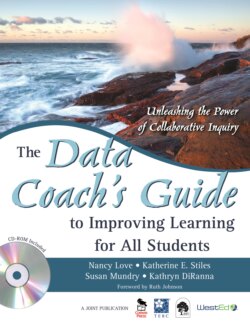Читать книгу The Data Coach's Guide to Improving Learning for All Students - Katherine E. Stiles - Страница 20
Assumption 6:
ОглавлениеEvery member of a collaborative school community can act as a leader, dramatically impacting the quality of relationships, the school culture, and student learning.
The Using Data Process supports and promotes distributed leadership, where all staff members take full responsibility and do their parts to get the job—academic success for all students—done. Marzano, Waters, and McNulty (2005) identified 21 leadership behaviors correlated with student academic achievement. Virtually all of these 21 responsibilities, which include celebrating accomplishments, challenging the status quo, fostering shared beliefs and community, staying focused on goals, communicating ideas and beliefs, actively engaging others in decision making and instructional improvement, and fostering strong relationships, are functions of Data Coaches and Data Team members as well as of school and district administrators. In particular, data use is no longer a specialty of the assessment or central office or the principal. Everyone in the school understands and uses data in ways that contribute to instructional improvement.
Becoming a Data Coach and building Data Teams is all about developing the ability to think, speak, and act differently—to act as courageous leaders. Educators we work with often ask us, “How do we deal with resignation in our schools?” or “How do we get more people to believe that all students can learn?” One answer is to be full of possibility yourself, to frequently, succinctly, and clearly articulate what you believe, and to consistently act on those beliefs. We have seen Data Teams shift their direction completely when one team member took a clear stand against tracking students and provided evidence of its damaging effects. In Johnson County, Tennessee, the former superintendent, Mrs. Minnie Miller, and other district leaders consistently communicated two messages: “the little engine that could” and “what is is.” Virtually everyone in the district knew what they meant: “All kids can, do, and will learn,” and “stop focusing on what we have no control over.” When asked to what they attributed their dramatic success—virtually closing the gap between students with exceptional needs and general education students in one year, in all grade levels and every content area—teachers and principals consistently reported that they were inspired by those two messages.
